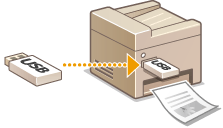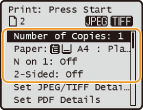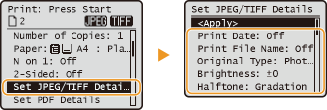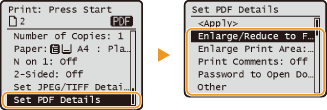Printing from USB Memory (USB Print)
You can print files stored in a USB memory device by connecting it directly to the machine. Using this function, you can print without using a computer. Make sure that this function is enabled before operation (Restricting the USB Print Function).

Available File Formats
You can print the following types of files.
JPEG (DCF/Exif 2.21 or earlier/JFIF)
TIFF (JPEG/MH/MR/MMR compression)
PDF* (1.7)
|
|
* Only available when the optional USB Direct Print Kit (for PDF) or PS Printer Kit is enabled.
|
|
NOTE
|
|
For JPEG and TIFF files, maximum printable data size per file*1 is 50 MB*2.
*1 For multi-page TIFF files, maximum data size is per page.
*2 Maximum data size is 20 MB when Secure Print is enabled.
For PDF files, maximum printable data size per file is 2 GB.
Note that even some files smaller than the size described above may not be printed correctly.
|
Available USB Memory Devices
You can use USB memory devices with the following format styles.
FAT16 (memory capacity: up to 2 GB)
FAT32 (memory capacity: up to 32 GB)
|
IMPORTANT
|
|
Do not use non-standard USB memory devices. You may not be able to print the files properly with some USB memory devices.
Do not connect anything other than a USB memory device. USB memory devices cannot be connected via a USB hub or an extension cable.
Do not use USB memory devices with special functions such as built-in security functions.
|
|
NOTE
|
|
If a folder in a USB memory device has many files, scanning files to print will take more time. Use your computer to delete unnecessary files on your USB memory device or move them to a different folder.
|
1
Connect a USB memory device to the USB memory port.

IMPORTANT:
The USB port on the right side of the machine toward the rear is not available.
Do not disconnect, jostle, or turn OFF the machine or USB memory device while the data is being transferred.
2
Press  (DIRECT PRINT).
(DIRECT PRINT).
 (DIRECT PRINT).
(DIRECT PRINT).3
Use  /
/ to select <Select File and Print>, and press
to select <Select File and Print>, and press  .
.
 /
/ to select <Select File and Print>, and press
to select <Select File and Print>, and press  .
.
NOTE:
Index Print
Index Print
You can print thumbnails of the image files (JPEG only) stored in a USB memory device. To print the images in thumbnails, select <Index Print> on the screen, and proceed to the next step.
 To change the file sort order
To change the file sort order
You can change the sort order of the files in a USB memory device.
NOTE:
You can specify a sort setting such as <Name (Ascending)> or <Date/Time (Ascending)> as the default setting for the file sort order. File Sort Default Settings
You can specify a sort setting such as <Name (Ascending)> or <Date/Time (Ascending)> as the default setting for the file sort order. File Sort Default Settings
|
1
|
Select <Sort Files>, and press
 . . |
|
2
|
Select the criteria for file sorting, and press
 . . |
|
NOTE:
When you select <Date/Time (Ascending)> or <Date/Time (Descending)>, files are sorted based on the modification dates and time of the files.
|
4
Select the file to print, and press  .
.
 .
.You can select multiple files.

To clear a selection, select the file you have selected (marked as  ), and press
), and press  .
.
 ), and press
), and press  .
.To display the contents of a folder, select a folder, and press  or
or  . To return to the folder in the upper level, press
. To return to the folder in the upper level, press  (Back) or
(Back) or  .
.
 or
or  . To return to the folder in the upper level, press
. To return to the folder in the upper level, press  (Back) or
(Back) or  .
.NOTE:
Folders and files lower than the third directory are not displayed.
When you move to another folder, the previous file selections will be cleared.
You cannot select JPEG/TIFF documents and PDF documents at the same time.
 To select all files
To select all files
Select <Select All>, and press  . All the displayed files are selected.
. All the displayed files are selected.
 . All the displayed files are selected.
. All the displayed files are selected.
To clear all selections, select <Clear All>, and press  .
.
 .
.5
Select <Apply>, and press  .
.
 .
.
6
Specify the print settings as necessary.
 To specify the print settings for all file formats
To specify the print settings for all file formats
Use  /
/ to select the settings, press
to select the settings, press  and specify each setting.
and specify each setting.
 /
/ to select the settings, press
to select the settings, press  and specify each setting.
and specify each setting.
<Number of Copies>
Specify the number of copies from 1 to 99. Use /
/ or the numeric keys to enter a quantity, and press
or the numeric keys to enter a quantity, and press  .
.
Specify the number of copies from 1 to 99. Use
 /
/ or the numeric keys to enter a quantity, and press
or the numeric keys to enter a quantity, and press  .
.
<Paper>
Select the paper to print on. Use /
/ to select the paper, and press
to select the paper, and press  .
.
Select the paper to print on. Use
 /
/ to select the paper, and press
to select the paper, and press  .
.
<N on 1>
You can print two or four images onto a single sheet. Use /
/ to select <2 on 1> or <4 on 1>, and press
to select <2 on 1> or <4 on 1>, and press  .
.
You can print two or four images onto a single sheet. Use
 /
/ to select <2 on 1> or <4 on 1>, and press
to select <2 on 1> or <4 on 1>, and press  .
.
 <2 on 1>
<2 on 1>
Prints two images onto a single sheet.
 <4 on 1>
<4 on 1>
Prints four images onto a single sheet.
NOTE:
<N on 1> is not available for printing TIFF files.
<N on 1> is not available for printing TIFF files.
<2-Sided>
You can make 2-sided printouts. Use /
/ to select the binding position, and press
to select the binding position, and press  .
.
You can make 2-sided printouts. Use
 /
/ to select the binding position, and press
to select the binding position, and press  .
.
 <Book Type>
<Book Type>
Prints images in such a way that the printed pages are opened horizontally when bound.

 <Calendar Type>
<Calendar Type>
Prints images in such a way that the printed pages are opened vertically when bound.

|
NOTE:
<2-Sided> may not be available with some sizes or types of paper. Paper
You can specify the 2-sided setting by pressing
 (2-Sided/ID Card Copy), instead of selecting <2-Sided> as the procedure described above. (2-Sided/ID Card Copy), instead of selecting <2-Sided> as the procedure described above. |
 To specify the print settings only for JPEG/TIFF files
To specify the print settings only for JPEG/TIFF files
Use  /
/ to select <Set JPEG/TIFF Details>
to select <Set JPEG/TIFF Details> 

 specify the setting
specify the setting 

 <Apply>
<Apply>
 .
.
 /
/ to select <Set JPEG/TIFF Details>
to select <Set JPEG/TIFF Details> 

 specify the setting
specify the setting 

 <Apply>
<Apply>
 .
.
<Print Date>
You can print the modification date of the file below each image. Use /
/ to select <On>, and press
to select <On>, and press  .
.
You can print the modification date of the file below each image. Use
 /
/ to select <On>, and press
to select <On>, and press  .
.
NOTE:
Although <Print Date> is not available for Index Print, the modification date of the file is automatically printed below each image.
Although <Print Date> is not available for Index Print, the modification date of the file is automatically printed below each image.
<Print File Name>
You can print the file name below each image. Use /
/ to select <On>, and press
to select <On>, and press  .
.
You can print the file name below each image. Use
 /
/ to select <On>, and press
to select <On>, and press  .
.
NOTE:
Although <Print File Name> is not available for Index Print, the file name is automatically printed below each image.
Although <Print File Name> is not available for Index Print, the file name is automatically printed below each image.
<Original Type>
You can select the type of original depending on the image to print. Use /
/ to select <Photo Priority> or <Text Priority>, and press
to select <Photo Priority> or <Text Priority>, and press  .
.
You can select the type of original depending on the image to print. Use
 /
/ to select <Photo Priority> or <Text Priority>, and press
to select <Photo Priority> or <Text Priority>, and press  .
.
 <Text Priority>
<Text Priority>
Gives priority to printing text clearly.
 <Photo Priority>
<Photo Priority>
Gives priority to printing photo images smoothly.
<Brightness>
You can adjust the brightness of printouts. Use /
/ to adjust the brightness, and press
to adjust the brightness, and press  .
.
You can adjust the brightness of printouts. Use
 /
/ to adjust the brightness, and press
to adjust the brightness, and press  .
.
 <–>
<–>
Prints images darker.
 <+>
<+>
Prints images brighter.
NOTE:
You can adjust the brightness of TIFF files only when they are JPEG-compressed.
You can adjust the brightness of TIFF files only when they are JPEG-compressed.
<Halftones>
You can select the printing method to reproduce halftones (the intermediate range between the lighter and darker areas of an image) for optimal image quality. Use /
/ to select <Gradation> or <Error Diffusion>, and press
to select <Gradation> or <Error Diffusion>, and press  .
.
You can select the printing method to reproduce halftones (the intermediate range between the lighter and darker areas of an image) for optimal image quality. Use
 /
/ to select <Gradation> or <Error Diffusion>, and press
to select <Gradation> or <Error Diffusion>, and press  .
.
 <Gradation>
<Gradation>
Prints images with fine gradation, such as digital camera images, with a smooth finish.
 <Error Diffusion>
<Error Diffusion>
Prints images with small text or fine lines with a clear finish.
 To specify the print settings only for PDF files
To specify the print settings only for PDF files
Use  /
/  to select <Set PDF Details>
to select <Set PDF Details> 

 specify the setting
specify the setting 

 <Apply>
<Apply>
 .
.
 /
/  to select <Set PDF Details>
to select <Set PDF Details> 

 specify the setting
specify the setting 

 <Apply>
<Apply>
 .
.
<Enlarge/Reduce to Fit Paper Size>
You can print original PDF files in the size automatically enlarged or reduced to fit the selected paper size. Use /
/ to select <On>, and press
to select <On>, and press  .
.
You can print original PDF files in the size automatically enlarged or reduced to fit the selected paper size. Use
 /
/ to select <On>, and press
to select <On>, and press  .
.
<Enlarge Print Area>
You can eliminate the margin and extend the printable area to the edges of the paper. Use /
/ to select <On>, and press
to select <On>, and press  .
.
You can eliminate the margin and extend the printable area to the edges of the paper. Use
 /
/ to select <On>, and press
to select <On>, and press  .
.
NOTE:
If you select <On>, some portions of the image may be missing near the edge of the paper or the paper may be partly tainted depending on the original.
If you select <On>, some portions of the image may be missing near the edge of the paper or the paper may be partly tainted depending on the original.
<Print Comments>
You can print PDF files with all the comments. Use /
/ to select <Auto>, and press
to select <Auto>, and press  .
.
You can print PDF files with all the comments. Use
 /
/ to select <Auto>, and press
to select <Auto>, and press  .
.
<Password to Open Document>
You can print the PDF file protected with a password by entering a password for opening the file. Enter the password, and press .
.
You can print the PDF file protected with a password by entering a password for opening the file. Enter the password, and press
 .
.
<Other>
You can specify the settings to achieve optimal print results. Use /
/  to select the setting
to select the setting 

 specify the setting
specify the setting 

 <Apply>
<Apply> 
 .
.
You can specify the settings to achieve optimal print results. Use
 /
/  to select the setting
to select the setting 

 specify the setting
specify the setting 

 <Apply>
<Apply> 
 .
.
 <Halftones>
<Halftones>
See Halftones for the description of the setting.
 <Grayscale Conversion>
<Grayscale Conversion>
See Grayscale Conversion for the description of the setting.
 <Print Quality>
<Print Quality>
See Print Quality for the description of the setting.
7
Press  .
.
 .
.Printing starts.
To cancel print jobs, select <Cancel> 

 <Yes>
<Yes> 
 .
.


 <Yes>
<Yes> 
 .
.8
Disconnect the USB memory device from the USB memory port.
|
1
|
Press
 . . |
|
2
|
Press
 (Status Monitor). (Status Monitor). |
|
3
|
Use
 / / to select <Device Status>, and press to select <Device Status>, and press  . . |
|
4
|
Select <Remove Memory Media>, and press
 . .Wait until the <Memory media can be safely removed.> message is displayed.
|
|
5
|
Disconnect the USB memory device.
|
|
TIPS
|
|
If you always want to print with the same settings: Changing Default USB Print Settings
|